Utilizing Forest Trees for Mitigation of Low-Frequency Ground Vibration Induced by Railway Operation
Abstract
1. Introduction
2. Semi-Analytical Solution for the Coupled Track–Ground–Tree Grid System
2.1. Fundamental Solutions to the Dynamic Response of a Stratified Half-Space
2.2. Coupling the Trees onto the Ground Surface
2.3. Coupling of the Track to the Tree Grid–Ground System
3. Numerical Studies
3.1. Attenuation Performance of Forest Trees for Different Number of Loads
3.2. Attenuation Performance of Different Tree Distribution Areas
3.3. Attenuation Performance of Forest Trees Forming a Metawedge
3.4. Impact of Stochastic Tree Parameters on Attenuation Performance
4. Conclusions
- (1)
- Tree grids produce considerable attenuation performance for train loads. Due to the interaction of wave fields excited by multiple harmonic point loads at different locations, the attenuation efficiency varies significantly within 5–50 Hz across surface positions, with observation points farther from the tree grid exhibiting lower attenuation efficiency. Moreover, the attenuation performance tends to weaken by 1–3 dB with an increasing number of carriages.
- (2)
- A wider tree distribution area, especially along the direction of the track, leads to more effective vibration mitigation, and the differences in ARS can reach 12 dB at farther points. Compared with the ordinary tree grid, trees arranged with a height gradient in the direction perpendicular to the track can capture Rayleigh waves induced by train loads and convert them into bulk shear waves, thereby achieving more significant attenuation performance within 10–63 Hz.
- (3)
- Under random variations in tree parameters (height, radius, and density) with a ±40% fluctuation range, height induces the largest uncertainty, with ARS fluctuations up to 1.7 dB at close points in the 8–16 Hz range; radius has minimal effect, with variations under 1.2 dB at most; when all parameters vary simultaneously, the uncertainty can reach 2 dB (low-frequency) and 1 dB (high-frequency), but the grid still maintains attenuation performance within 8–32 Hz and 63–80 Hz. In addition, due to the propagation of low-frequency surface waves around the tree grid toward distant observation points, the uncertainty in attenuation performance at those points tends to reduce within the low-frequency range while amplifying across the high-frequency range.
Author Contributions
Funding
Data Availability Statement
Conflicts of Interest
Appendix A
| Parameter | value |
|---|---|
| Shear wave speed of the soil, Cs | 900 m/s |
| Longitudinal wave speed of the soil, CP | 500 m/s |
| Density of the soil, ρS | 1200 kg/m3 |
| Young’s modulus of the tree, Et | 1.70 × 109 N/m2 |
| Poisson’s ratio of the tree, vt | 0.281 |
| Density of the tree, ρt | 450 kg/m3 |

References
- Popović, Z.; Lazarević, L.; Vukićević, M.; Vilotijević, M.; Mirković, N. The Modal Shift to Sustainable Railway Transport in Serbia. MATEC Web Conf. 2017, 106, 05001. [Google Scholar] [CrossRef]
- Zou, C.; Li, X.; He, C.; Zhou, S. An Efficient Method for Estimating Building Dynamic Response Due to Train Operations in Tunnel Considering Transmission Path from Source to Receiver. Comput. Struct. 2024, 305, 107555. [Google Scholar] [CrossRef]
- Qiu, Y.; Zheng, B.; Jiang, B.; Jiang, S.; Zou, C. Effect of Non-Structural Components on Over-Track Building Vibrations Induced by Train Operations on Concrete Floor. Int. J. Str. Stab. Dyn. 2025, 2650180. [Google Scholar] [CrossRef]
- Tao, Z.; Zhang, D.; Tu, D.; He, L.; Zou, C. Prediction of Train-Induced Ground-Borne Vibration Transmission Considering Parametric Uncertainties. Probabilistic Eng. Mech. 2025, 79, 103731. [Google Scholar] [CrossRef]
- He, C.; Jia, Y.; Zhou, S.; Chen, X. An Efficient Semi-Analytical Method for Dynamic Responses of a Tunnel in Stratified Soils with Irregular Interfaces. J. Sound Vib. 2025, 614, 119191. [Google Scholar] [CrossRef]
- Zhou, S.; Tian, Z.; Yao, Q.; Dai, L. Rethinking Tunnel-Soil Relative Stiffness: Insights from Interactions between Tunnels and Strata Subjected to Ground Surcharge. Int. J. Rail Transp. 2025, 1–16. [Google Scholar] [CrossRef]
- Johansson, A.; Nielsen, J.C.O.; Bolmsvik, R.; Karlström, A.; Lundén, R. Under Sleeper Pads—Influence on Dynamic Train–Track Interaction. Wear 2008, 265, 1479–1487. [Google Scholar] [CrossRef]
- Guigou-Carter, C.; Villot, M.; Guillerme, B.; Petit, C. Analytical and Experimental Study of Sleeper SAT S 312 in Slab Track Sateba System. J. Sound Vib. 2006, 293, 878–887. [Google Scholar] [CrossRef]
- Alves Costa, P.; Calçada, R.; Silva Cardoso, A. Ballast Mats for the Reduction of Railway Traffic Vibrations. Numerical Study. Soil Dyn. Earthq. Eng. 2012, 42, 137–150. [Google Scholar] [CrossRef]
- Woods, R.D. Screening of Surface Wave in Soils. J. Soil Mech. Found. Div. 1968, 94, 951–979. [Google Scholar] [CrossRef]
- François, S.; Schevenels, M.; Thyssen, B.; Borgions, J.; Degrande, G. Design and Efficiency of a Composite Vibration Isolating Screen in Soil. Soil Dyn. Earthq. Eng. 2012, 39, 113–127. [Google Scholar] [CrossRef]
- Takemiya, H.; Fujiwara, A. Wave Propagation/Impediment in a Stratum and Wave Impeding Block (WIB) Measured for SSI Response Reduction. Soil Dyn. Earthq. Eng. 1994, 13, 49–61. [Google Scholar] [CrossRef]
- Krylov, V.V. Scattering of Rayleigh Waves by Heavy Masses as Method of Protection against Traffic-Induced Ground Vibrations. In Environmental Vibrations: Prediction, Monitoring, Mitigation and Evaluation; CRC Press: Boca Raton, FL, USA, 2005. [Google Scholar]
- Talbot, J.P. Base-Isolated Buildings: Towards Performance-Based Design. Proc. Inst. Civ. Eng. Struct. Build. 2016, 169, 574–582. [Google Scholar] [CrossRef]
- Nielsen, J.C.O.; Mirza, A.; Cervello, S.; Huber, P.; Müller, R.; Nelain, B.; Ruest, P. Reducing Train-Induced Ground-Borne Vibration by Vehicle Design and Maintenance. Int. J. Rail Transp. 2015, 3, 17–39. [Google Scholar] [CrossRef]
- Hemsworth, B. Reducing Groundborne Vibrations: State-of-the-Art Study. J. Sound Vib. 2000, 231, 703–709. [Google Scholar] [CrossRef]
- Thompson, D.J.; Jiang, J.; Toward, M.G.R.; Hussein, M.F.M.; Ntotsios, E.; Dijckmans, A.; Coulier, P.; Lombaert, G.; Degrande, G. Reducing Railway-Induced Ground-Borne Vibration by Using Open Trenches and Soft-Filled Barriers. Soil Dyn. Earthq. Eng. 2016, 88, 45–59. [Google Scholar] [CrossRef]
- Wenbo, Y.; Yingchao, S.; Dexiong, L.; Tao, Z.; Qixiang, Y.; Yong, F.; Chuan, H. An Experimental Study of the Isolation Performance of Trenches on Ground-Borne Vibration from Underground Tunnels. Earthq. Eng. Eng. Vib. 2020, 19, 779–790. [Google Scholar] [CrossRef]
- Peplow, A.T.; Jones, C.J.C.; Petyt, M. Surface Vibration Propagation over a Layered Elastic Half-Space with an Inclusion. Appl. Acoust. 1999, 56, 283–296. [Google Scholar] [CrossRef]
- Andersen, L.; Nielsen, S.R.K. Reduction of Ground Vibration by Means of Barriers or Soil Improvement along a Railway Track. Soil Dyn. Earthq. Eng. 2005, 25, 701–716. [Google Scholar] [CrossRef]
- Jones, C.J.C. Use of Numerical Models to Determine the Effectiveness of Anti-Vibration Systems for Railways. Proc. Inst. Civ. Eng. Transp. 1994, 105, 43–51. [Google Scholar] [CrossRef]
- Dijckmans, A.; Coulier, P.; Jiang, J.; Toward, M.G.R.; Thompson, D.J.; Degrande, G.; Lombaert, G. Mitigation of Railway Induced Ground Vibration by Heavy Masses next to the Track. Soil Dyn. Earthq. Eng. 2015, 75, 158–170. [Google Scholar] [CrossRef]
- Romero García, V. On the Control of Propagating Acoustic Waves in Sonic Crystals: Analytical, Numerical and Optimization Techniques; Universitat Politècnica de València: Valencia, Spain, 2010. [Google Scholar] [CrossRef]
- Noguchi, Y.; Yamada, T. Topology Optimization of Acoustic Metasurfaces by Using a Two-Scale Homogenization Method. Appl. Math. Model. 2021, 98, 465–497. [Google Scholar] [CrossRef]
- Brûlé, S.; Javelaud, E.H.; Enoch, S.; Guenneau, S. Experiments on Seismic Metamaterials: Molding Surface Waves. Phys. Rev. Lett. 2014, 112, 133901. [Google Scholar] [CrossRef] [PubMed]
- Pu, X.; Shi, Z. Surface-Wave Attenuation by Periodic Pile Barriers in Layered Soils. Constr. Build. Mater. 2018, 180, 177–187. [Google Scholar] [CrossRef]
- Li, T.; Su, Q.; Kaewunruen, S. Seismic Metamaterial Barriers for Ground Vibration Mitigation in Railways Considering the Train-Track-Soil Dynamic Interactions. Constr. Build. Mater. 2020, 260, 119936. [Google Scholar] [CrossRef]
- Ma, M.; Jiang, B.; Liu, W.; Liu, K. Control of Metro Train-Induced Vibrations in a Laboratory Using Periodic Piles. Sustainability 2020, 12, 5871. [Google Scholar] [CrossRef]
- Huang, J.; Liu, W.; Shi, Z. Surface-Wave Attenuation Zone of Layered Periodic Structures and Feasible Application in Ground Vibration Reduction. Constr. Build. Mater. 2017, 141, 1–11. [Google Scholar] [CrossRef]
- Castanheira-Pinto, A.; Alves-Costa, P.; Godinho, L.; Amado-Mendes, P. On the Application of Continuous Buried Periodic Inclusions on the Filtering of Traffic Vibrations: A Numerical Study. Soil Dyn. Earthq. Eng. 2018, 113, 391–405. [Google Scholar] [CrossRef]
- He, C.; Zhou, S.; Guo, P. Mitigation of Railway-Induced Vibrations by Using Periodic Wave Impeding Barriers. Appl. Math. Model. 2022, 105, 496–513. [Google Scholar] [CrossRef]
- Sheng, X. A Review on Modelling Ground Vibrations Generated by Underground Trains. Int. J. Rail Transp. 2019, 7, 241–261. [Google Scholar] [CrossRef]
- Achaoui, Y.; Ungureanu, B.; Enoch, S.; Brûlé, S.; Guenneau, S. Seismic Waves Damping with Arrays of Inertial Resonators. Extrem. Mech. Lett. 2016, 8, 30–37. [Google Scholar] [CrossRef]
- Palermo, A.; Vitali, M.; Marzani, A. Metabarriers with Multi-Mass Locally Resonating Units for Broad Band Rayleigh Waves Attenuation. Soil Dyn. Earthq. Eng. 2018, 113, 265–277. [Google Scholar] [CrossRef]
- Basone, F.; Wenzel, M.; Bursi, O.S.; Fossetti, M. Finite Locally Resonant Metafoundations for the Seismic Protection of Fuel Storage Tanks. Earthq. Eng. Struct. Dyn. 2019, 48, 232–252. [Google Scholar] [CrossRef]
- Wang, X.; Wan, S.; Nian, Y.; Zhou, P.; Zhu, Y. Periodic In-Filled Pipes Embedded in Semi-Infinite Space as Seismic Metamaterials for Filtering Ultra-Low-Frequency Surface Waves. Constr. Build. Mater. 2021, 313, 125498. [Google Scholar] [CrossRef]
- Williams, E.G.; Roux, P.; Rupin, M.; Kuperman, W.A. Theory of Multiresonant Metamaterials for A_0 Lamb Waves. Phys. Rev. B 2015, 91, 104307. [Google Scholar] [CrossRef]
- Chaplain, G.J.; De Ponti, J.M.; Aguzzi, G.; Colombi, A.; Craster, R.V. Topological Rainbow Trapping for Elastic Energy Harvesting in Graded Su-Schrieffer-Heeger Systems. Phys. Rev. Appl. 2020, 14, 054035. [Google Scholar] [CrossRef]
- Pu, X.; Palermo, A.; Marzani, A. Lamb’s Problem for a Half-Space Coupled to a Generic Distribution of Oscillators at the Surface. Int. J. Eng. Sci. 2021, 168, 103547. [Google Scholar] [CrossRef]
- Zeng, C.; Zhao, C.; Zeighami, F. Seismic Surface Wave Attenuation by Resonant Metasurfaces on Stratified Soil. Earthq. Eng. Struct. Dyn. 2022, 51, 1201–1223. [Google Scholar] [CrossRef]
- Colombi, A.; Roux, P.; Guenneau, S.; Gueguen, P.; Craster, R.V. Forests as a Natural Seismic Metamaterial: Rayleigh Wave Bandgaps Induced by Local Resonances. Sci. Rep. 2016, 6, 19238. [Google Scholar] [CrossRef]
- Roux, P.; Bindi, D.; Boxberger, T.; Colombi, A.; Cotton, F.; Douste-Bacque, I.; Garambois, S.; Gueguen, P.; Hillers, G.; Hollis, D.; et al. Toward Seismic Metamaterials: The METAFORET Project. Seismol. Res. Lett. 2018, 89, 582–593. [Google Scholar] [CrossRef]
- Colombi, A.; Colquitt, D.; Roux, P.; Guenneau, S.; Craster, R.V. A Seismic Metamaterial: The Resonant Metawedge. Sci. Rep. 2016, 6, 27717. [Google Scholar] [CrossRef] [PubMed]
- He, C.; Zhou, S.; Li, X.; Di, H.; Zhang, X. Forest Trees as a Natural Metamaterial for Surface Wave Attenuation in Stratified Soils. Constr. Build. Mater. 2023, 363, 129769. [Google Scholar] [CrossRef]
- Muhammad; Wu, T.; Lim, C.W. Forest Trees as Naturally Available Seismic Metamaterials: Low Frequency Rayleigh Wave with Extremely Wide Bandgaps. Int. J. Str. Stab. Dyn. 2020, 20, 2043014. [Google Scholar] [CrossRef]
- Muhammad; Lim, C.W. Natural Seismic Metamaterials: The Role of Tree Branches in the Birth of Rayleigh Wave Bandgap for Ground Born Vibration Attenuation. Trees 2021, 35, 1299–1315. [Google Scholar] [CrossRef]
- Colquitt, D.J.; Colombi, A.; Craster, R.V.; Roux, P.; Guenneau, S.R.L. Seismic Metasurfaces: Sub-Wavelength Resonators and Rayleigh Wave Interaction. J. Mech. Phys. Solids 2017, 99, 379–393. [Google Scholar] [CrossRef]
- Marigo, J.-J.; Pham, K.; Maurel, A.; Guenneau, S. Effective Model for Elastic Waves in a Substrate Supporting an Array of Plates/Beams with Flexural and Longitudinal Resonances. J. Elast. 2021, 146, 143–177. [Google Scholar] [CrossRef]
- Liu, Y.; Huang, J.; Li, Y.; Shi, Z. Trees as Large-Scale Natural Metamaterials for Low-Frequency Vibration Reduction. Constr. Build. Mater. 2019, 199, 737–745. [Google Scholar] [CrossRef]
- Lysmer, J.; Waas, G. Shear Waves in Plane Infinite Structures. J. Eng. Mech. Div. 1972, 98, 85–105. [Google Scholar] [CrossRef]
- Waas, G. Linear Two-Dimensional Analysis of Soil Dynamics Problems in Semi-Infinite Layered Media. Ph.D. Thesis, University of California, Berkeley, CA, USA, 1972. [Google Scholar]
- Park, J. Wave Motion in Finite and Infinite Media Using the Thin-Layer Method. Ph.D. Thesis, Massachusetts Institute of Technology, Cambridge, MA, USA, 2002. Available online: https://dspace.mit.edu/handle/1721.1/43616 (accessed on 12 June 2025).
- Graff, K.F. Wave Motion in Elastic Solids; Courier Corporation: North Chelmsford, MA, USA, 2012. [Google Scholar]
- Sneddon, I.N. Fourier Transforms; Courier Corporation: North Chelmsford, MA, USA, 1995. [Google Scholar]
- Kausel, E. Thin-Layer Method: Formulation in the Time Domain. Int. J. Numer. Methods Eng. 1994, 37, 927–941. [Google Scholar] [CrossRef]
- Barbosa, J.M.D.O.; Park, J.; Kausel, E. Perfectly Matched Layers in the Thin Layer Method. Comput. Methods Appl. Mech. Eng. 2012, 217–220, 262–274. [Google Scholar] [CrossRef]
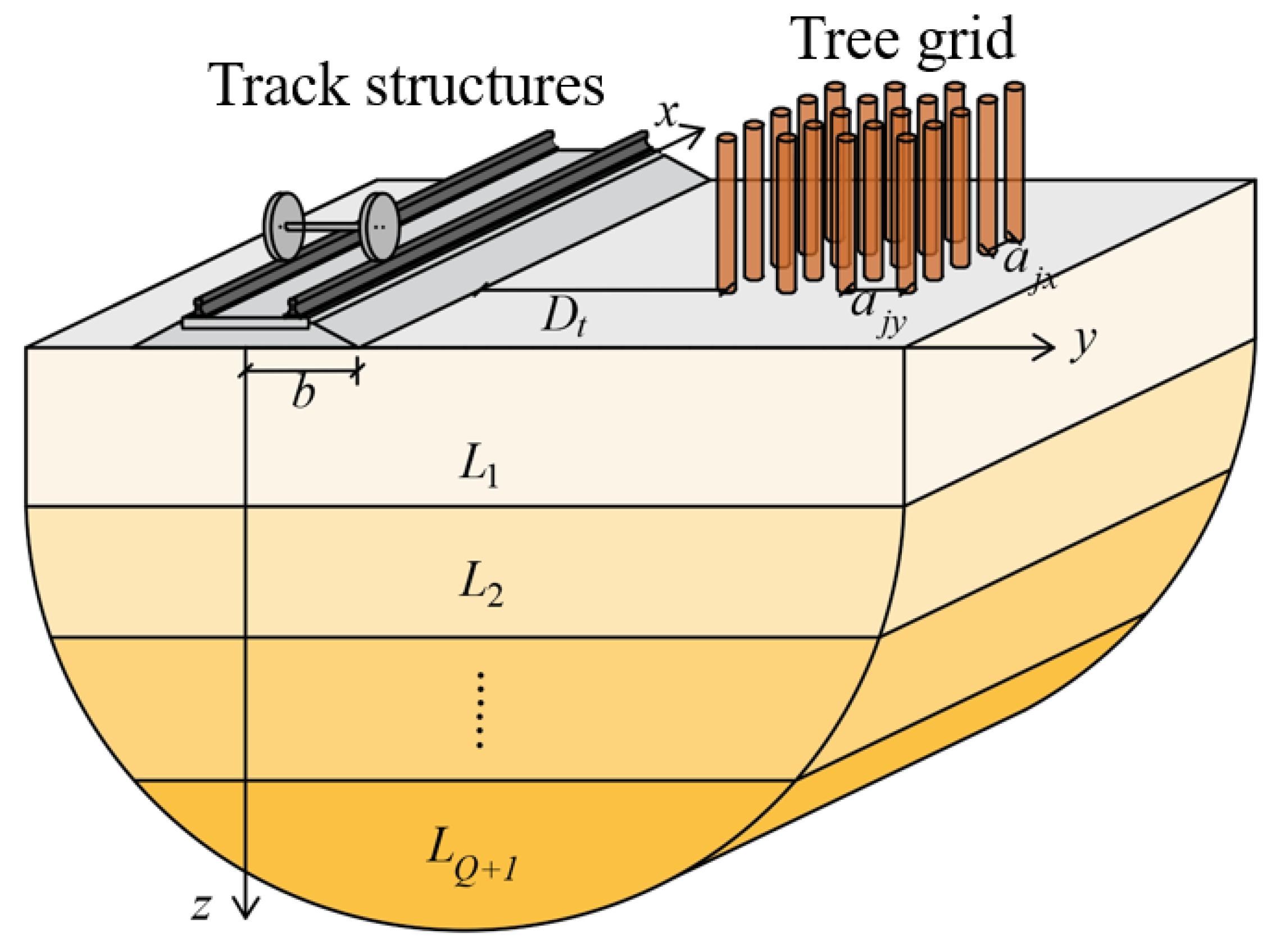
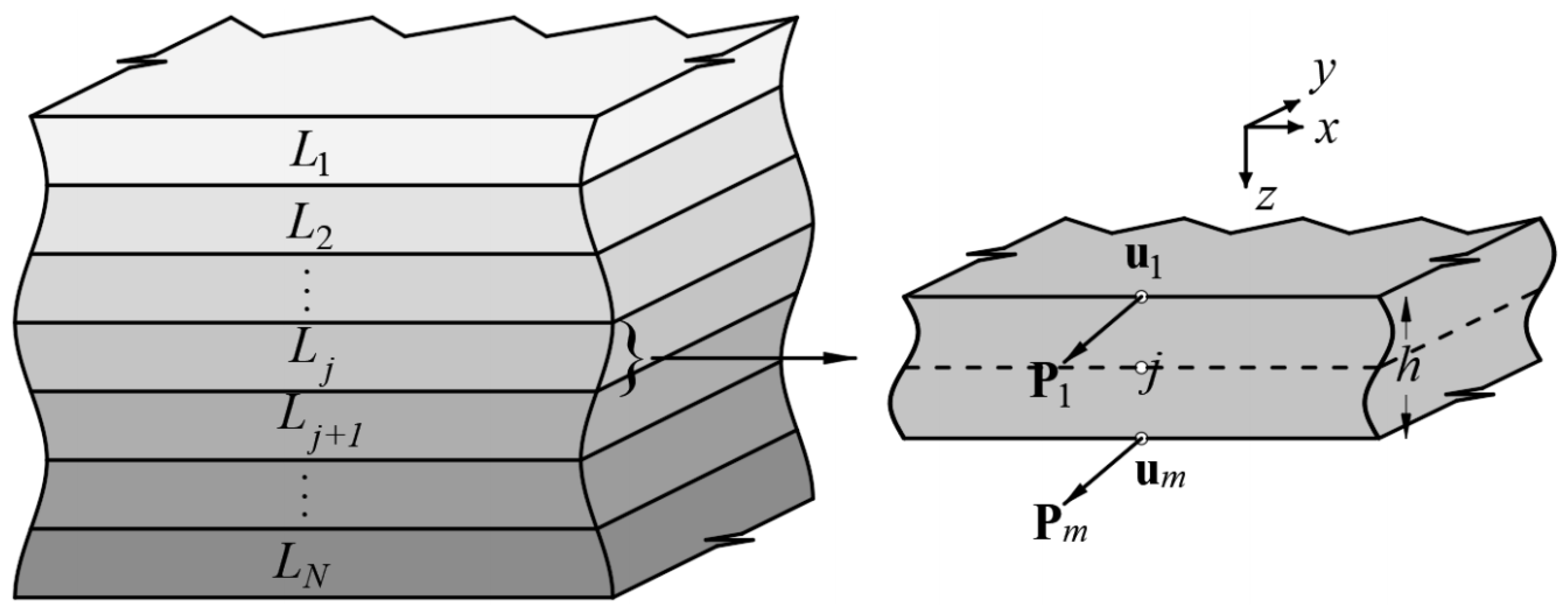
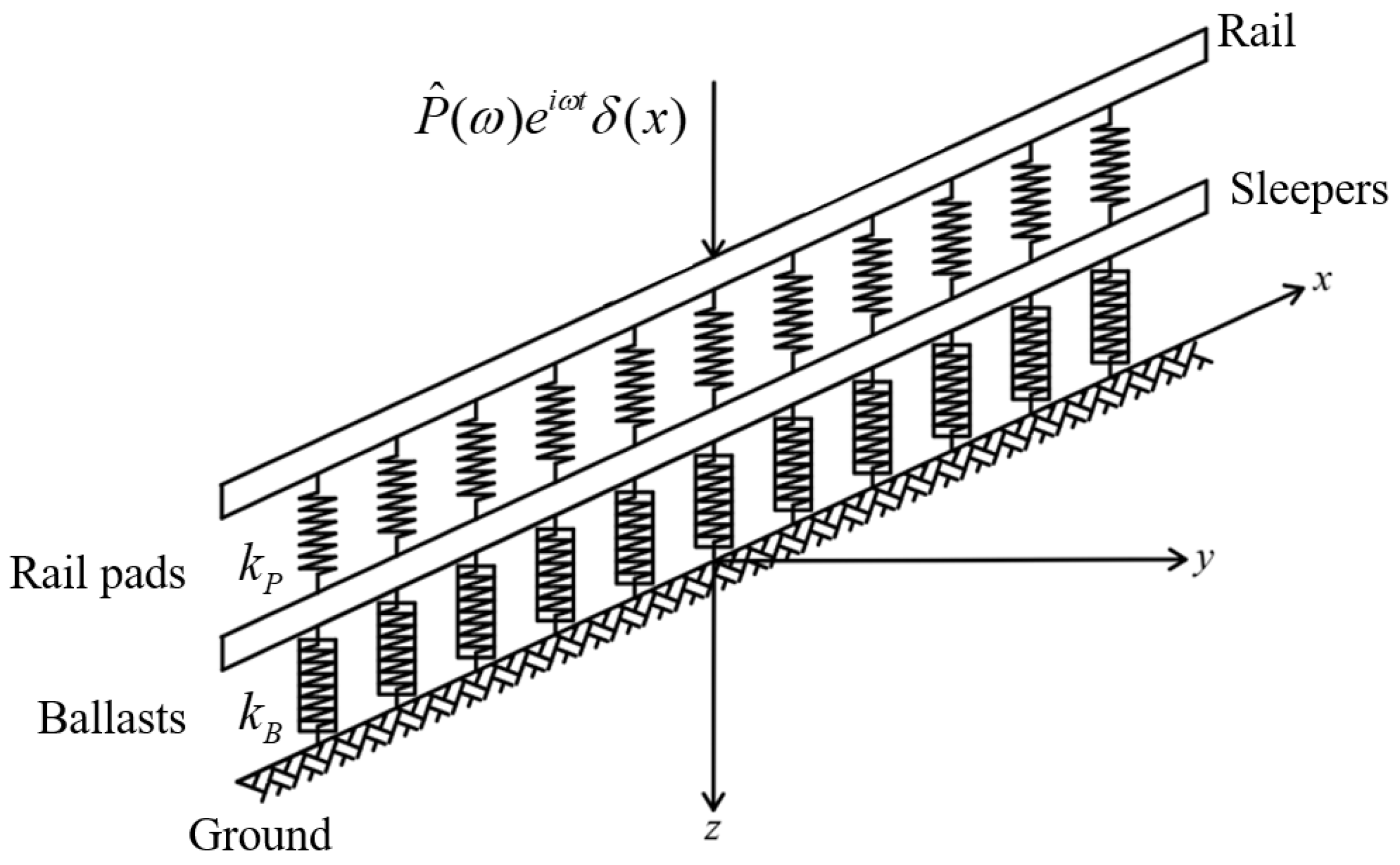


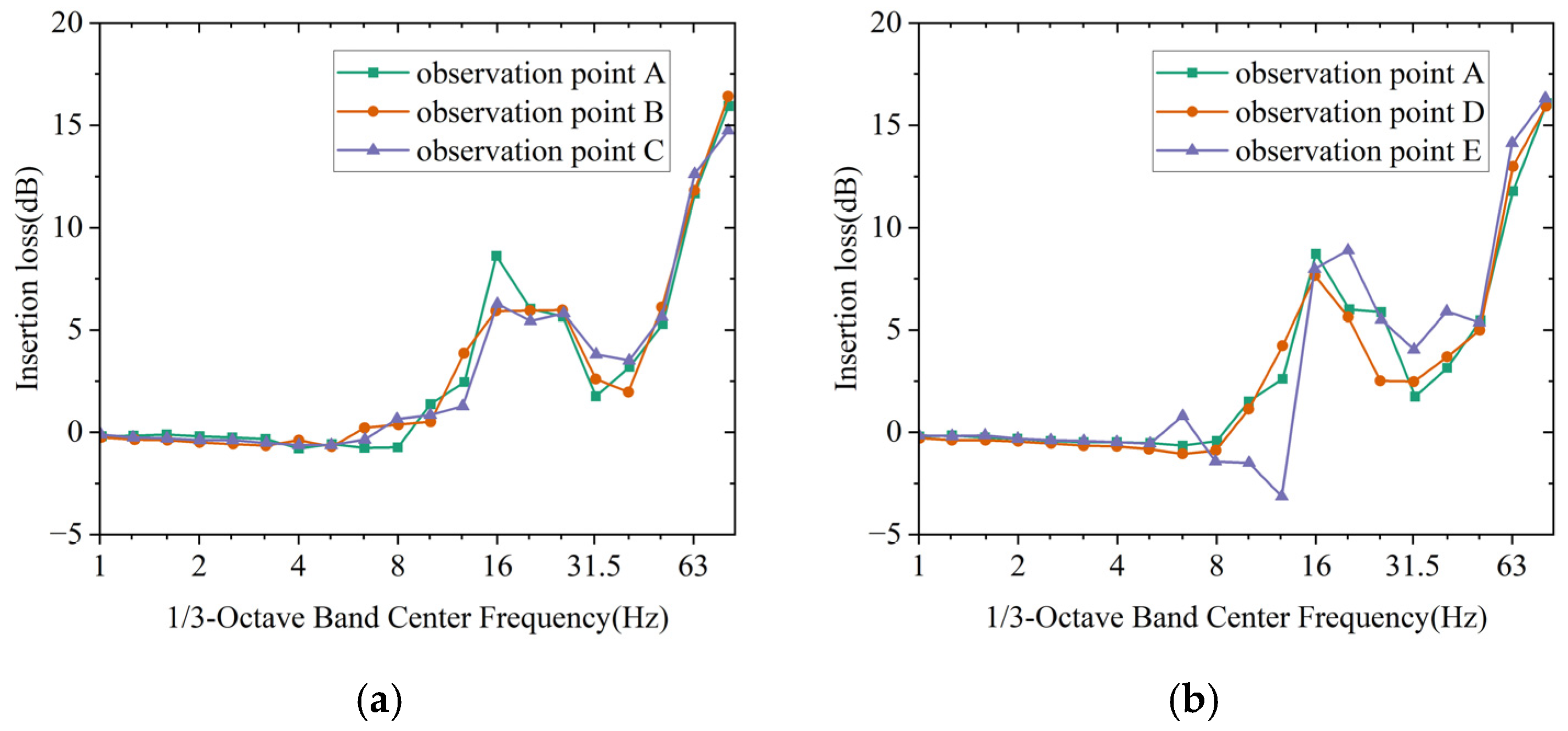
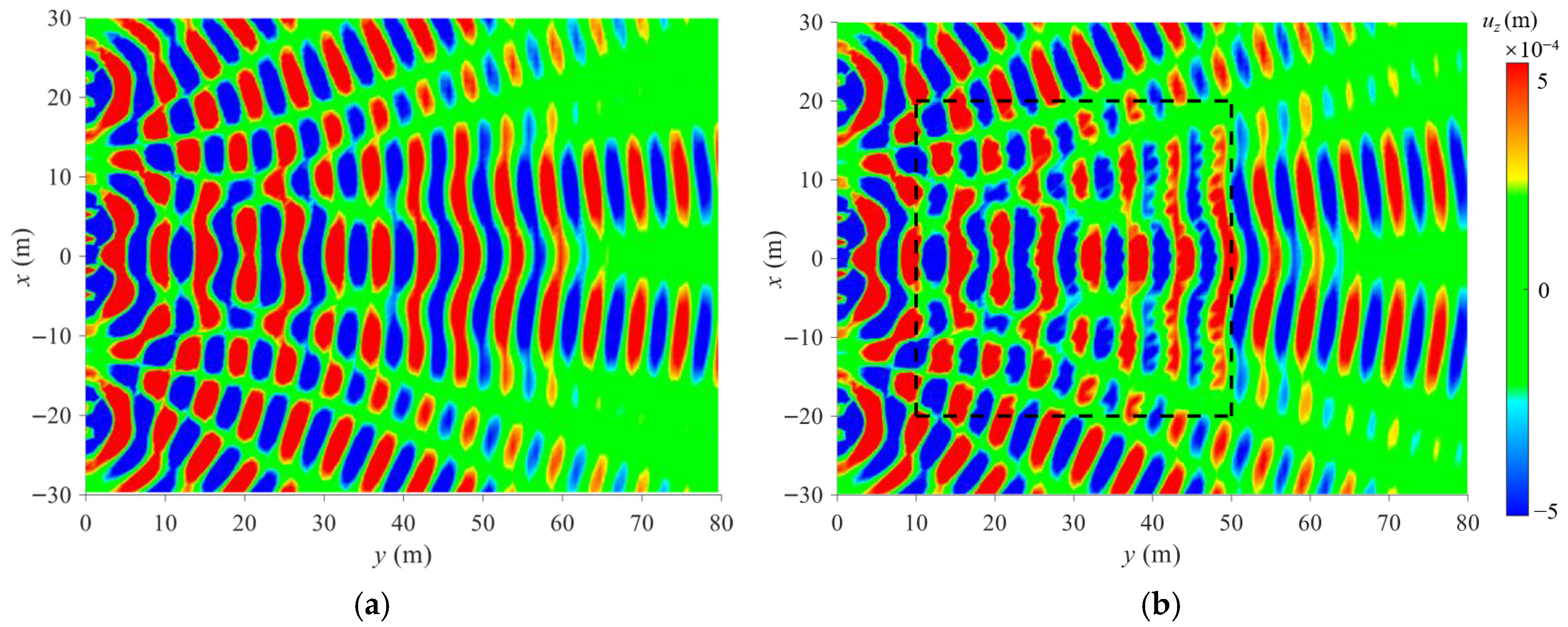
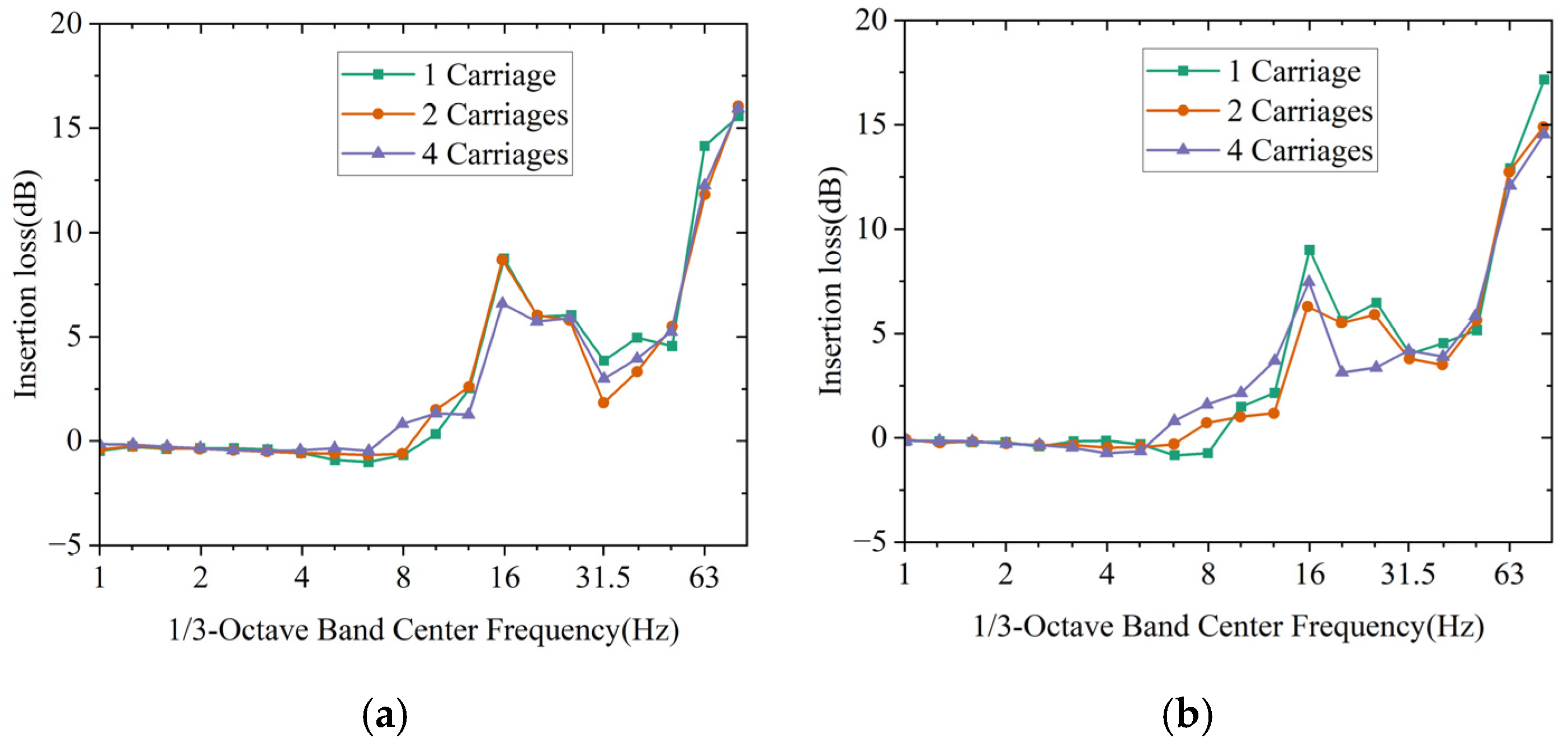





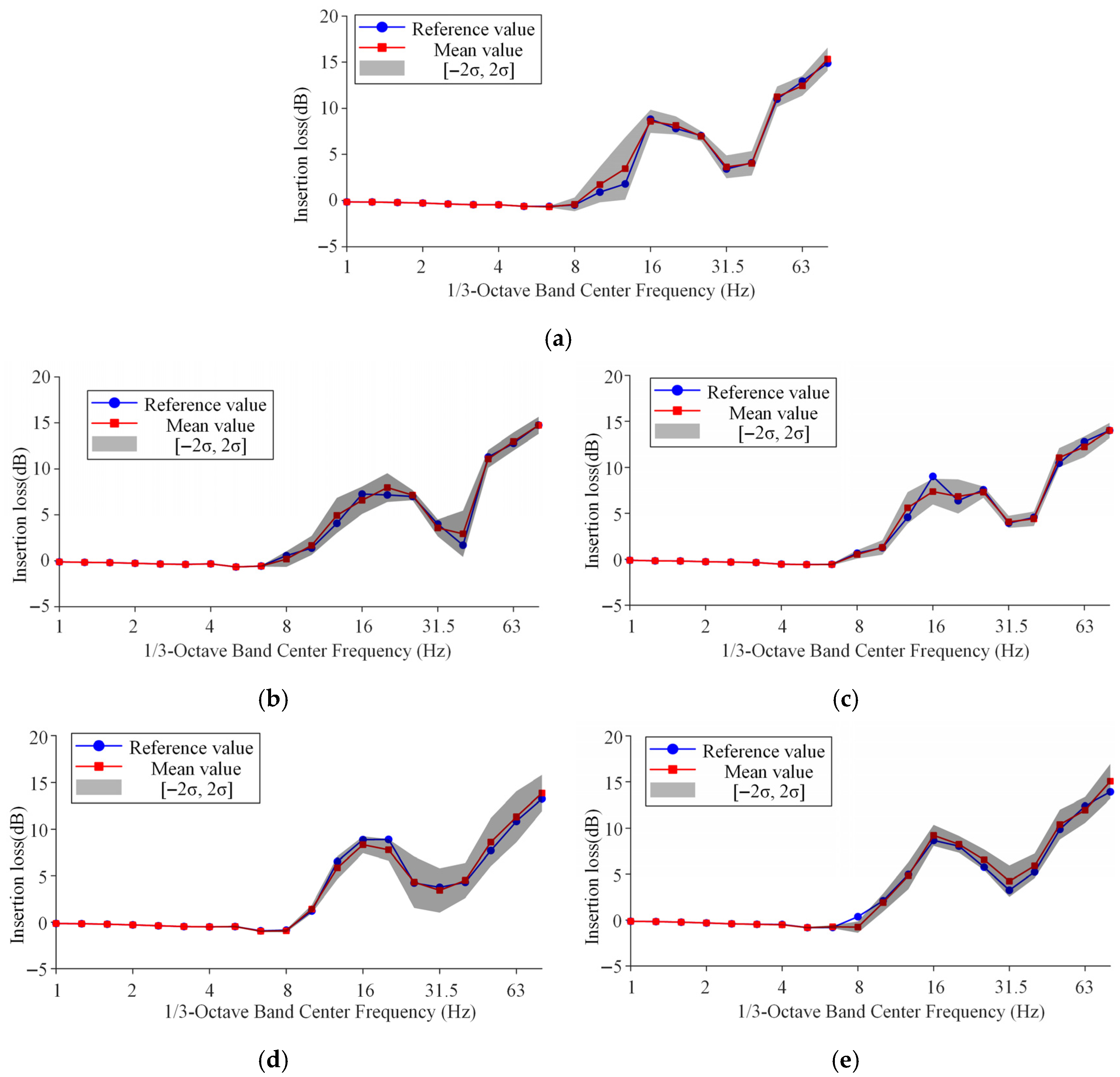
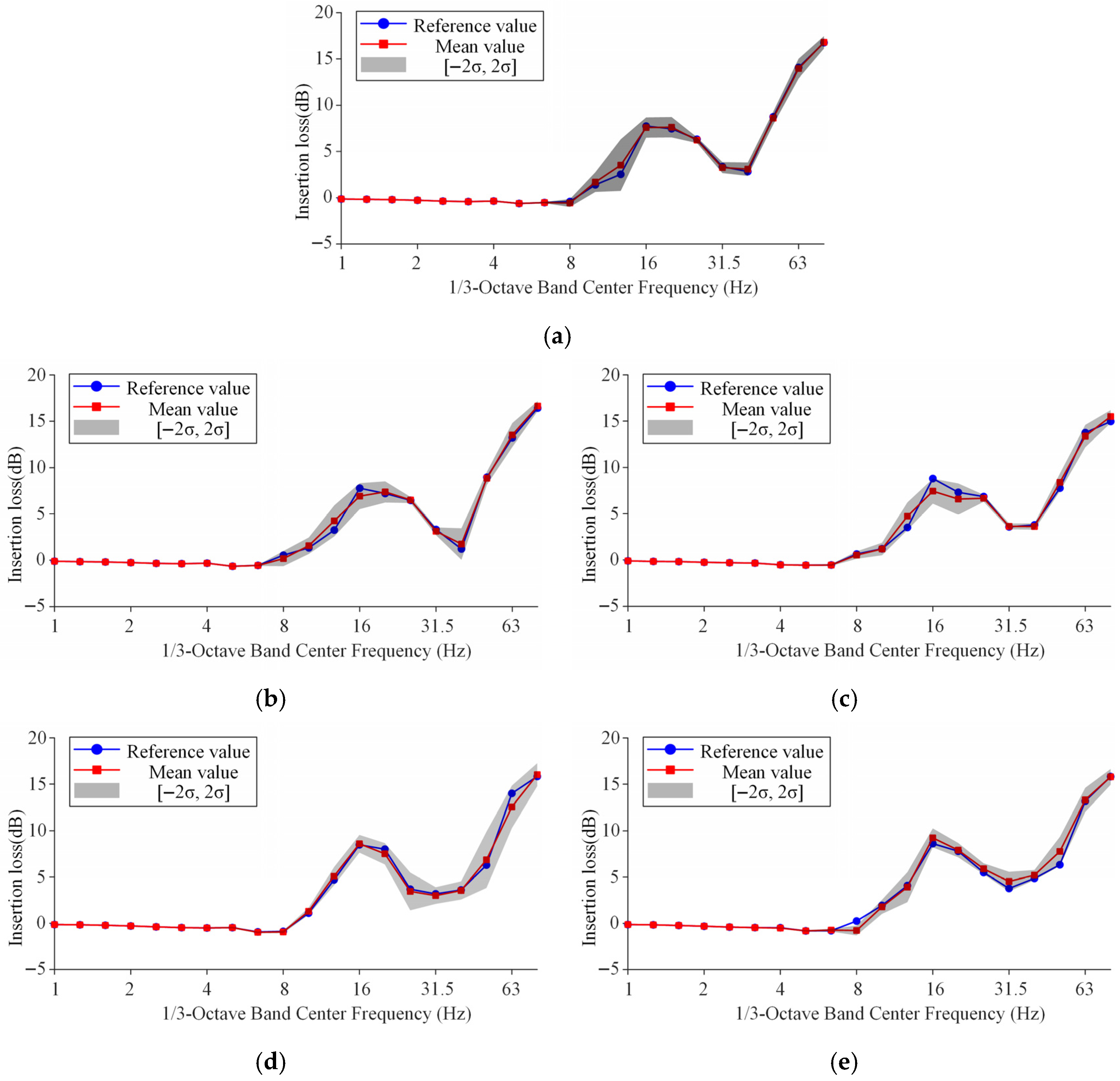
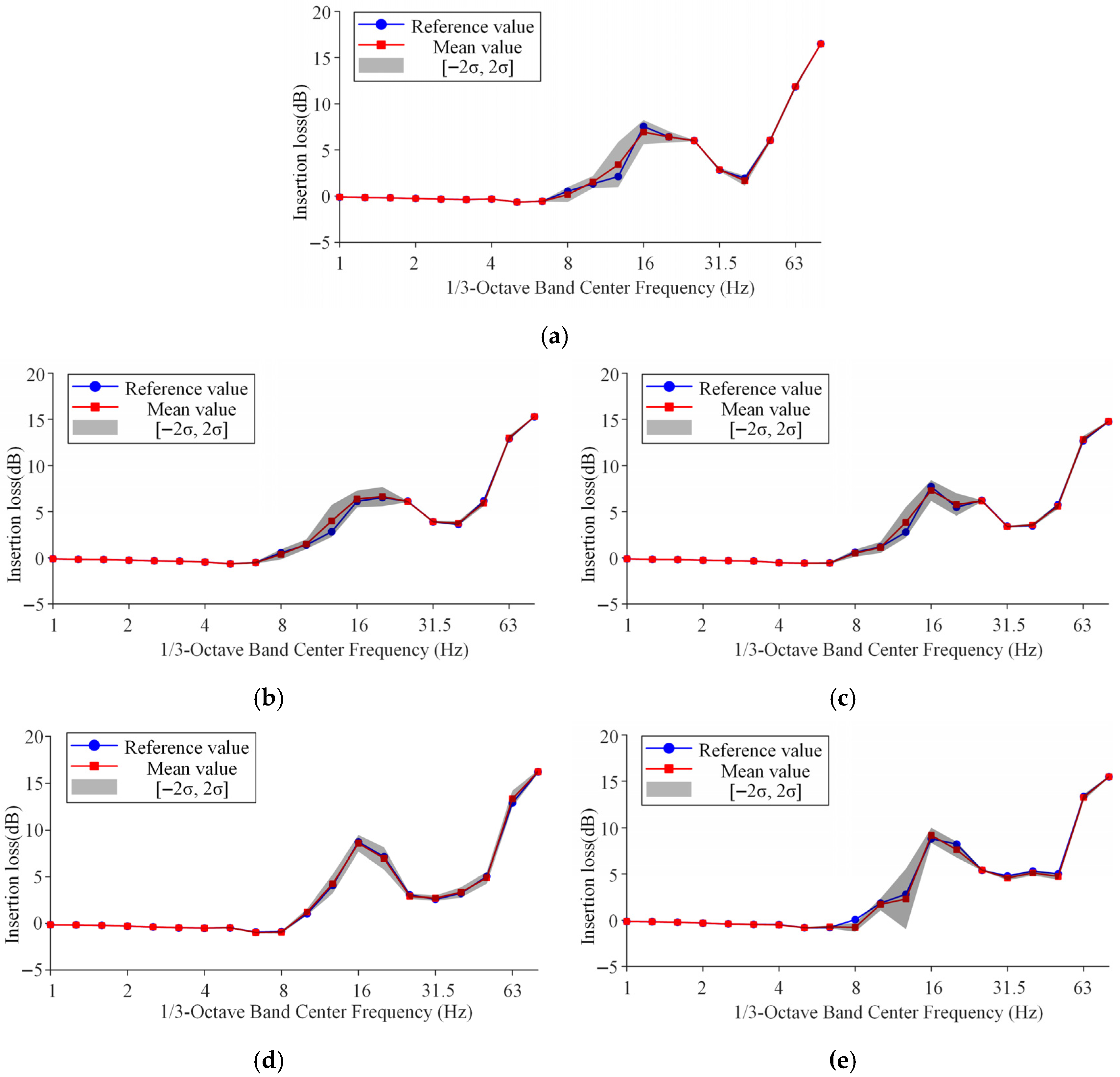
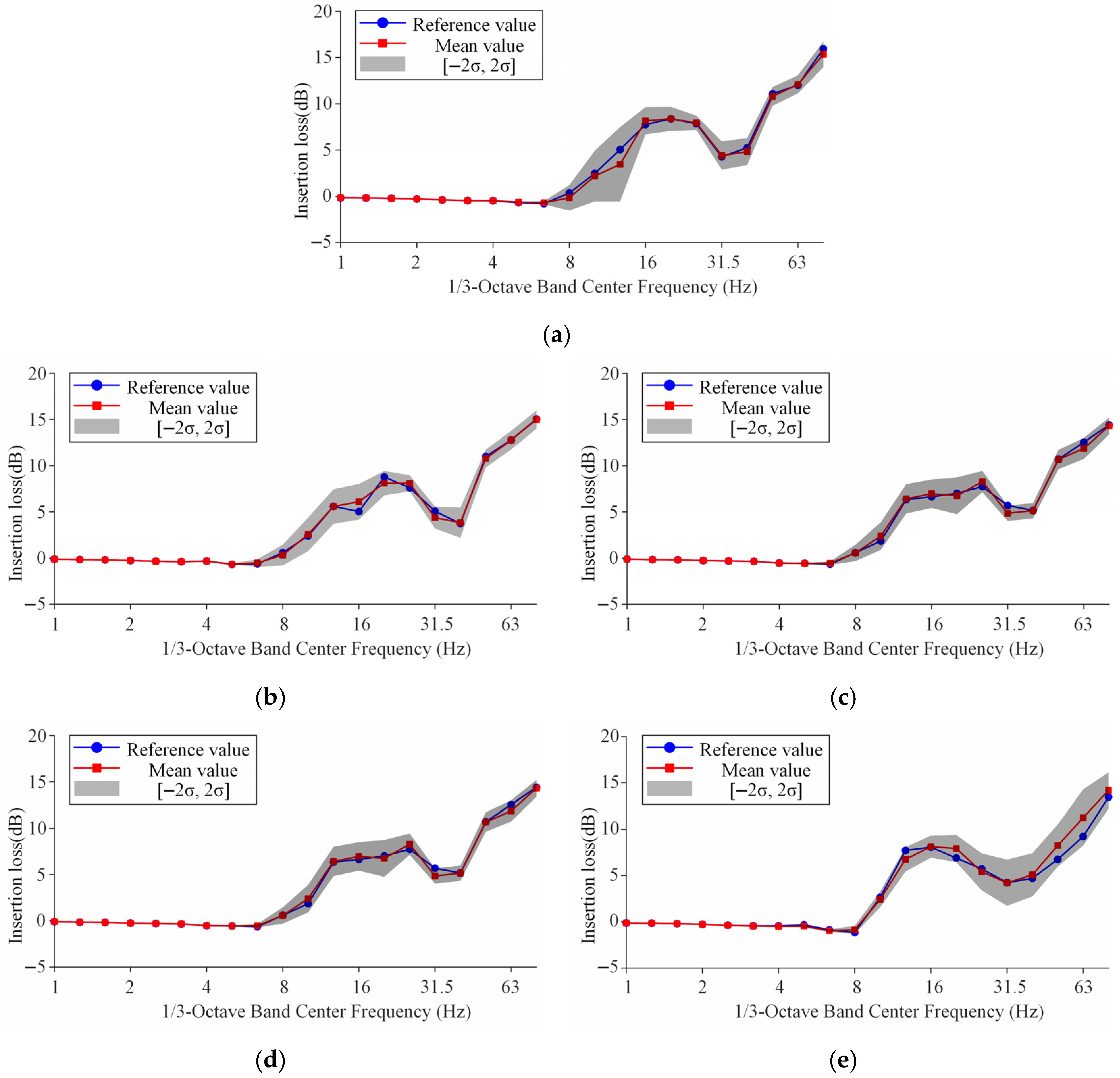
| Parameter | Value |
|---|---|
| Mass of the rail beam per unit length of the track, mR | 120 kg/m |
| Mass of sleepers per unit length of the track, mS | 490 kg/m |
| Mass of ballast per unit length of the track, mB | 1200 kg/m |
| Bending stiffness of the rail beam, EI | 1.26 × 107 N/m2 |
| Rail pad stiffness, kP | 3.5 × 108 N/m2 |
| Ballast stiffness per unit length of the track, kB | 3.50 × 108 N/m2 |
| Width of the ballast, 2a | 2.70 m |
| Rail pad loss factor, ηR | 0.15 |
| Parameter | Value |
|---|---|
| Shear wave speed of the soil, Cs | 100 m/s |
| Longitudinal wave speed of the soil, CP | 200 m/s |
| Density of the soil, ρS | 1800 kg/m3 |
| Young’s modulus of the tree, Et | 1.67 × 109 N/m2 |
| Poisson’s ratio of the tree, vt | 0.3 |
| Density of the tree, ρt | 700 kg/m3 |
| Parameter | Value |
|---|---|
| Lateral spacing of the tree grid (y-axis direction), ajy | 2 m |
| Longitudinal spacing of the tree grid (x-axis direction), ajx | 2 m |
| Distance from the track, Dt | 10 m |
| Number of lateral trees, Ny | 20 |
| Number of longitudinal trees, Nx | 20 |
| Radius of the tree, r | 0.25 m |
| Height of the tree, h | 14 m |
Disclaimer/Publisher’s Note: The statements, opinions and data contained in all publications are solely those of the individual author(s) and contributor(s) and not of MDPI and/or the editor(s). MDPI and/or the editor(s) disclaim responsibility for any injury to people or property resulting from any ideas, methods, instructions or products referred to in the content. |
© 2025 by the authors. Licensee MDPI, Basel, Switzerland. This article is an open access article distributed under the terms and conditions of the Creative Commons Attribution (CC BY) license (https://creativecommons.org/licenses/by/4.0/).
Share and Cite
Zhang, Z.; Zhang, X.; Tian, Z.; He, C. Utilizing Forest Trees for Mitigation of Low-Frequency Ground Vibration Induced by Railway Operation. Appl. Sci. 2025, 15, 8618. https://doi.org/10.3390/app15158618
Zhang Z, Zhang X, Tian Z, He C. Utilizing Forest Trees for Mitigation of Low-Frequency Ground Vibration Induced by Railway Operation. Applied Sciences. 2025; 15(15):8618. https://doi.org/10.3390/app15158618
Chicago/Turabian StyleZhang, Zeyu, Xiaohui Zhang, Zhiyao Tian, and Chao He. 2025. "Utilizing Forest Trees for Mitigation of Low-Frequency Ground Vibration Induced by Railway Operation" Applied Sciences 15, no. 15: 8618. https://doi.org/10.3390/app15158618
APA StyleZhang, Z., Zhang, X., Tian, Z., & He, C. (2025). Utilizing Forest Trees for Mitigation of Low-Frequency Ground Vibration Induced by Railway Operation. Applied Sciences, 15(15), 8618. https://doi.org/10.3390/app15158618







